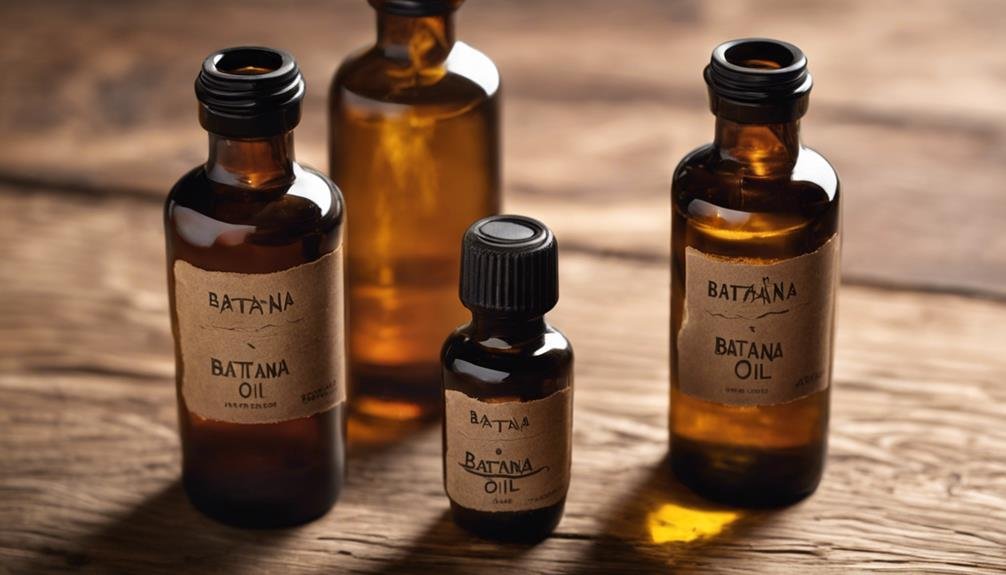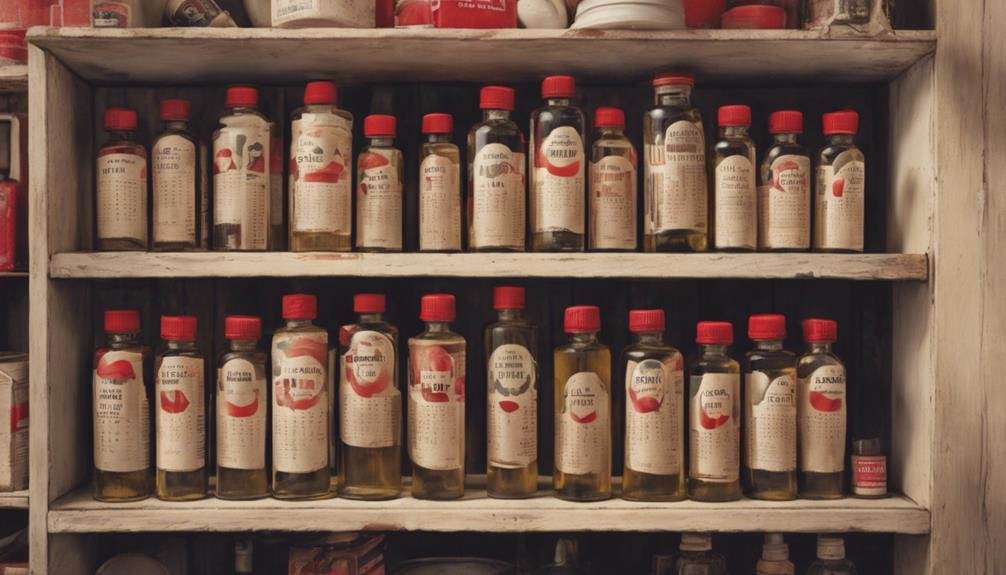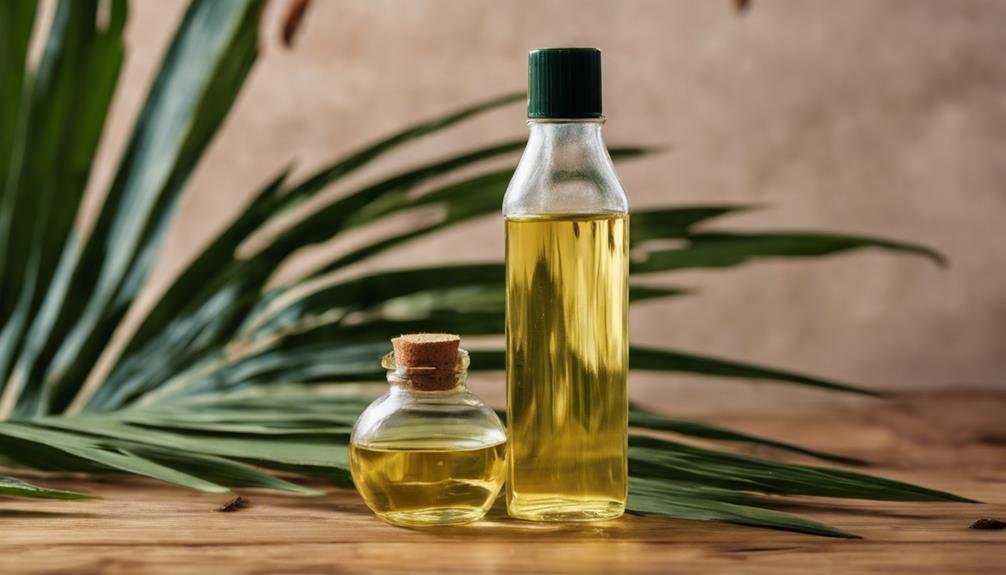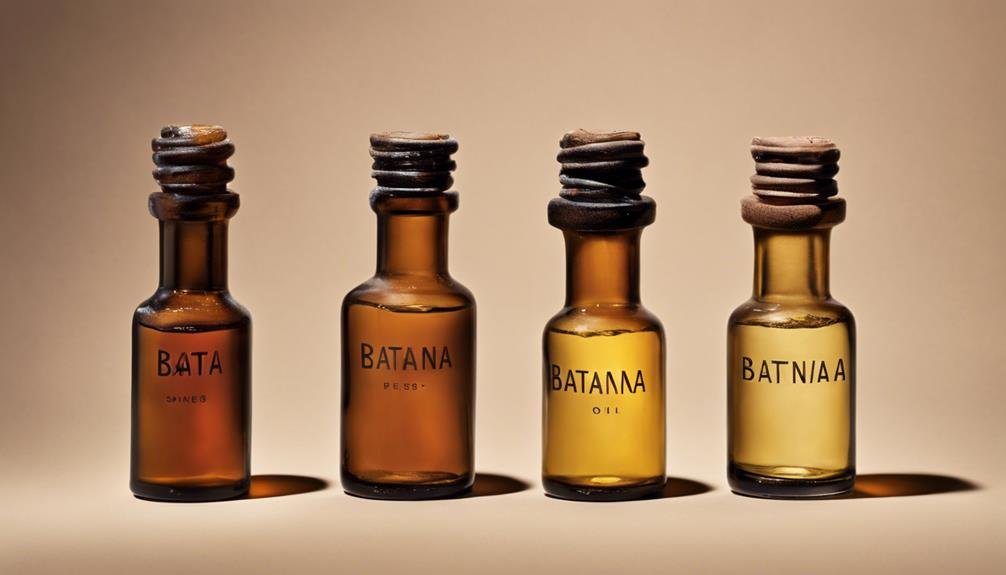When you're evaluating your batana oil for spoilage, you've got to be alert to a few telltale signs. If you notice any off-putting smells, changes in color, or a shift in texture, these could all indicate that your oil isn't what it used to be. It's essential to recognize these changes early, as spoiled oil can negatively impact the health of your hair and scalp. But, how can you be sure what you're seeing or smelling is a sign of spoilage and not just a natural characteristic of the oil? We'll explore some foolproof methods to confirm your suspicions.
Key Takeaways
- Check for rancid or unusual odors, as a bad smell is a primary indicator of spoilage.
- Look for changes in texture, such as grittiness or sliminess, which suggest contamination.
- Observe the color; discoloration like darkening or cloudiness often signals spoilage.
- Examine for sediment or floating particles, indicating degradation and contamination.
- Notice any separation or unusual consistency changes, which indicate oil destabilization and spoilage.
Understanding Batana Oil Spoilage
Although batana oil is renowned for its nourishing properties, it can deteriorate if not stored properly. You need to know how to prevent your batana oil from spoiling, as exposure to air, light, and heat can lead to oxidation and rancidity. This degradation not only diminishes its quality but can also affect its efficacy.
To combat this, make sure your batana oil is stored in a cool, dark place. Light can accelerate the spoilage process, so it's critical to keep it away from direct sunlight. An airtight container is your best bet to reduce exposure to air and moisture, which are prime contributors to the spoilage.
If batana oil comes into contact with moisture, it can lead to the growth of mold or bacteria, which is definitely something you want to avoid.
Regularly check your oil for signs of spoilage such as discoloration or an unusual texture. If the oil appears darker than usual or has a cloudy appearance, it might be a sign that it's no longer good.
Also, be wary of any sediment or floating particles, as these are indicators of contamination or degradation. By keeping these tips in mind, you'll extend the shelf life of your batana oil and enjoy its benefits for longer.
Signs of Oxidation
Recognizing signs of oxidation in your batana oil is crucial for maintaining its quality and effectiveness. If you detect a rancid smell, it's a clear hint that the oil is spoiling. This unpleasant odor is a common result of oxidation, a process that degrades the oil due to exposure to air, light, and heat.
Additionally, be wary of any sediment or floating particles in the oil. These impurities can signal contamination and are often associated with the oxidative degradation of the oil's components. Such changes not only imply spoilage but also question the safety and purity of the batana oil you're using.
The texture of the oil can also indicate issues. If your batana oil feels gritty or slimy, it suggests that it has undergone considerable oxidation and is likely past its prime. This alteration in texture can affect both the usability and the effectiveness of the oil.
To extend the shelf life and preserve the quality of your batana oil, minimize its exposure to air and light. Storing it in a cool, dark place can markedly slow down the oxidation process, helping to guarantee that you're using a product that remains potent and safe.
Changes in Appearance

Beyond oxidation signs, the physical appearance of batana oil provides clear indicators of its condition. If you notice any discoloration, such as darkening or cloudiness, it's a red flag that your oil might be spoiled. This change in color often accompanies other signs of spoilage and should caution you against using the oil further.
Moreover, the presence of sediment or floating particles is another telltale sign of contamination. These impurities suggest that the oil has undergone deterioration and is no longer in its pure state. This kind of contamination can occur from improper storage or from the oil being past its shelf life. You'll want to avoid using oil that shows these signs as it's likely compromised.
Additionally, if your batana oil emits a foul or rancid smell, this is a direct indicator of oxidation. Such a smell often correlates with visual changes like increased cloudiness or a shift toward a thicker consistency.
These sensory cues are your first line of defense in identifying spoiled batana oil. Remember, fresh batana oil should be clear, free of debris, and have a pleasant, characteristic scent. If it fails these checks, it's best to discard it to avoid any potential risks. Additionally, if you notice any unusual discoloration or a rancid odor, these are additional signs of spoiled batana oil. The oil should also not have a slimy or thick texture, as this indicates it has gone bad. Identifying spoiled batana oil is crucial for ensuring the safety and quality of your culinary creations.
Texture Alterations
As you inspect your batana oil, pay close attention to any unusual consistency changes; these might be a clue that the oil is no longer good.
If you notice the oil has become gritty or there's an occurrence of separation into layers, these are signs of spoilage or contamination.
Such texture alterations suggest that the oil mightn't only be unpleasant but potentially unsafe to use.
Unusual Consistency Changes
When you check your batana oil, pay close attention to its consistency; signs of spoilage often manifest through unusual changes in texture. If the oil has separated into layers or developed a thickened texture, it's a clear indication that it mightn't be fit for use. Fresh batana oil should have a smooth, uniform consistency, so any deviation from this could suggest degradation or contamination.
Watch out for sliminess or a sticky, tacky feel when you touch the oil. These textures are abnormal and typically indicate that the oil has undergone spoilage. This could be due to microbial growth or other forms of contamination that have compromised the quality of the oil.
Additionally, the presence of sediment or floating particles is a telltale sign of spoilage. This sediment can be the result of microbial growth within the oil, leading to health concerns if used on your skin or hair.
It's important to be vigilant for these signs of spoilage as using spoiled oil can counteract the beneficial effects you're seeking from batana oil, and potentially cause irritation or other undesirable reactions. Always opt for a replacement if you notice these issues.
Grittiness Development
Grittiness in your batana oil is a clear warning sign of spoilage. When you notice the texture of the oil has shifted from smooth to gritty, it's essential to reflect on the potential causes and implications. This change typically results from sedimentation of particles, often due to improper storage or contamination.
Such texture alteration not only indicates spoilage but also suggests the oil might've undergone oxidation, severely compromising its quality. Oxidation and sedimentation directly affect the oil's effectiveness, particularly in hair care applications where the quality of the oil impacts its benefits.
If you're using batana oil for its reputed hair nourishing properties, the presence of grittiness could drastically reduce its potency. It's important to conduct a thorough inspection of the oil if you detect any grittiness. This unusual texture is a definite indicator that the oil is no longer suitable for use and should be discarded.
Separation Occurrence
You should also watch for separation in your batana oil, a common sign that the oil's components are destabilizing. This can manifest as visible layers or a clear division of liquids within the container. If you notice such separation, it's a strong indicator that the oil may not only be spoiled but could also compromise its effectiveness, especially in hair and scalp treatments.
Separation typically hints at underlying issues like exposure to adverse conditions or the onset of rancidity, which drastically diminishes the quality of the oil.
Here's what you should look for when inspecting your batana oil for signs of spoilage:
- Cloudy Appearance: If the oil turns cloudy, it's often a sign of contamination or the initial stages of spoilage.
- Texture Changes: A smooth texture should be consistent; any grittiness or sliminess suggests spoilage.
- Sediment Formation: Check for sediment at the bottom of the bottle, which can indicate contamination.
- Viscosity Alterations: Significant changes in the oil's viscosity are a clear sign of degradation.
Regularly inspecting the texture and consistency of your batana oil is essential to ensuring you're using a quality product that's safe and effective.
Smell as an Indicator

You can easily identify spoiled batana oil by its smell.
If you notice a foul or rancid odor, it's a clear signal that the oil has undergone oxidation and is no longer good to use.
Trust your nose; a sour or off-putting scent is a definite sign that the oil should be discarded to avoid damaging your hair and scalp.
Identifying Rancid Odors
Detecting a rancid odor is a reliable method to identify spoiled batana oil. When this cherished oil goes bad, typically due to oxidation from exposure to air, its natural compounds break down, altering its scent dramatically.
Originally, fresh batana oil should greet your senses with a pleasant, nutty aroma. However, if it's spoiled, you'll notice a foul, off-putting smell similar to rotten fats.
Here's how you can conduct a simple smell test to verify the quality of your batana oil:
- Open the Container: Start by opening your batana oil container to expose the oil to your sense of smell.
- Take a Whiff: Lean in and take a cautious sniff. If the oil emits any strong, unpleasant odors, it's a red flag.
- Compare Scents: If possible, compare it with a fresh sample for a reference to what it should ideally smell like.
- Assess the Result: A rancid smell is a clear indication that the oil isn't only ineffective but could also irritate your scalp if used.
Always remember, using oil with a rancid odor isn't worth the risk. Always perform a smell test before application to avoid any potential scalp irritation or other issues.
Distinctive Spoilage Aromas
When batana oil turns bad, its distinctive spoilage aromas become a clear warning sign. You'll first notice that the pleasant, nutty aroma that typically characterizes fresh batana oil starts to morph into a foul or rancid smell. This shift indicates that the oil is spoiling, a process usually due to oxidation and degradation of the oil's quality.
Moreover, if you catch a sour or acrid odor, it could be a signal of microbial contamination. This isn't just unpleasant; it's also unsafe, especially if you're planning to use the oil on your skin or scalp.
Using spoiled batana oil mightn't only be ineffective but could also lead to scalp irritation or other adverse effects.
It's essential to trust your nose with this oil. If there's any significant change from its original scent, don't hesitate to discard the oil. It's better to be safe and avoid the potential adverse effects of using compromised batana oil.
Regular scent checks can save you from the frustration of ineffective treatment and the discomfort of possible skin reactions. Remember, keeping your batana oil fresh guarantees it remains an effective treatment.
Storage Mistakes
Storing batana oil improperly can greatly shorten its shelf life and degrade its quality. Understanding common storage mistakes can help you maintain the oil's effectiveness and purity. Here's what you need to avoid:
1. Warm or Humid Environment: Storing batana oil in a warm or humid place accelerates spoilage due to increased microbial growth and rancidity.
This kind of environment fosters conditions that compromise the oil's integrity.
2. Light Exposure: Keeping batana oil in transparent bottles where it's exposed to light considerably reduces the quality and nutrients, enhancing the risk of spoilage.
Light exposure triggers oxidation, which is detrimental to the oil's stability.
3. Loose Caps: Not securing the cap tightly allows air into the container, promoting oxidation and consequently, spoilage.
This exposure to air can drastically reduce the oil's shelf life and efficacy.
4. Unclean Containers: Transferring your oil into an unclean or used container introduces contaminants.
These contaminants can spoil the oil, reducing its purity and causing degradation.
Checking Expiry Dates

Always check the expiration date on your batana oil bottle before using it. This simple step is essential to guarantee you're applying a product that remains fresh and potent. Natural oils like batana have a limited shelf life, and using oil past its expiry date can lead to a decrease in both quality and effectiveness.
When purchasing products, it's wise to select bottles that are far from reaching their "best by" date. This practice gives you ample time to enjoy the maximum benefits of the oil. Here's a handy table to help you decide when to buy:
| Purchase Time | Best By Date | Expected Freshness |
|---|---|---|
| Immediately | +2 years | Most potent |
| After 1 year | +1 year | Moderately potent |
| Close to date | Few months | Least potent |
Impact on Hair Health
After confirming your batana oil hasn't expired, it's important to contemplate how its quality affects your hair's health. Spoiled batana oil can greatly detract from the nourishing benefits you expect, leading to various undesirable outcomes.
Here's how poor-quality batana oil could impact your hair and scalp:
- Reduced Hydration and Strength: Spoiled oil often undergoes oxidation, producing a rancid smell. This change compromises the oil's ability to effectively hydrate and strengthen your hair strands.
- Decreased Antioxidant Properties: Discoloration, like darkening or cloudiness, signals that the oil's antioxidant properties are compromised. This reduction can negatively affect your hair's liveliness and overall health.
- Contaminated Texture: An unusual texture, such as grittiness or sliminess, indicates contamination. This makes the oil less effective in repairing damage and promoting healthy hair growth.
- Scalp Irritation and Reactions: Using spoiled oil can lead to scalp irritation or even adverse reactions. This not only causes discomfort but also detracts from the oil's intended benefits for enhancing hair health and growth.
Always check for these signs to confirm you're using batana oil that truly benefits your hair.
Preventive Measures

To maximize the shelf life of your batana oil and keep it from spoiling, consider where and how you store it. Storing batana oil in a cool, dark place is vital as light and heat can accelerate spoilage and rancidity, compromising its quality.
Also, opting for airtight containers can greatly curb air exposure. Air leads to oxidation, which degrades the oil over time.
It's important to keep your oil away from moisture. Moisture can introduce bacteria that compromise the purity and quality of batana oil, leading to spoilage.
Always check the expiration date on your batana oil, and make certain you use it before this date to avoid the risks of using a spoiled product.
Be cautious when transferring batana oil to other vessels. Using unclean containers can introduce contaminants that may shorten its shelf life.
By following these simple steps, you'll guarantee that your batana oil remains fresh and effective for as long as possible.
Frequently Asked Questions
How to Spot Fake Batana Oil?
To spot fake batana oil, check the packaging; authentic batana oil is in dark bottles.
Look for certifications like Dr. Sebi's to guarantee quality.
Genuine batana oil should smell nutty, not chemical.
Be wary of low prices; they often indicate a diluted product.
Always verify the ingredients; pure batana oil doesn't contain additives.
Knowing these tips guarantees you're using authentic batana oil for its intended benefits and uses.
How to Use Spoiled Batana Oil for Hair?
You shouldn't use spoiled batana oil for your hair as it can harm your scalp and reduce hair benefits.
Instead, focus on proper storage to maintain oil quality. Always seek fresh, high-quality oil for effective moisture retention and hair growth.
Regularly apply as per recommended techniques and combine with suitable ingredients in DIY recipes to maximize scalp health and treatment frequency.
Be cautious with product sourcing to guarantee authenticity and effectiveness.
What Does Batana Oil Smell Like?
Batana oil, derived from the American oil palm, typically carries a pleasant, nutty aroma, highlighting its origin and natural extraction.
This scent reflects its rich nutrients and beneficial properties, vital in various applications, from hair care to skincare.
It's essential to distinguish its fresh, nutty smell from any off odors, indicating spoilage.
Understanding these sensory cues helps you leverage batana oil's benefits and guarantees you're using a quality product.
How Long Can I Keep Batana Oil in My Hair?
You can keep batana oil in your hair from 20 minutes to overnight, depending on your hair's needs.
For maximum benefits like improved hair health, moisture retention, and damage prevention, many opt to leave it overnight.
Safeguard proper storage techniques to maintain the oil's consistency and effectiveness.
Regular application supports scalp care and hair restoration, but remember to wash it out with a mild shampoo to avoid buildup and preserve the product's shelf life.
Conclusion
To guarantee your batana oil stays fresh, always store it properly and check the expiry date. If you notice any rancid smells, discoloration, or texture changes, it's likely spoiled. Don't risk using spoiled oil as it can harm your hair and scalp. Remember, clear oil with no sediment is what you're aiming for. Keep an eye out for these signs and take preventive measures to protect your oil from spoiling. Your hair will thank you!

